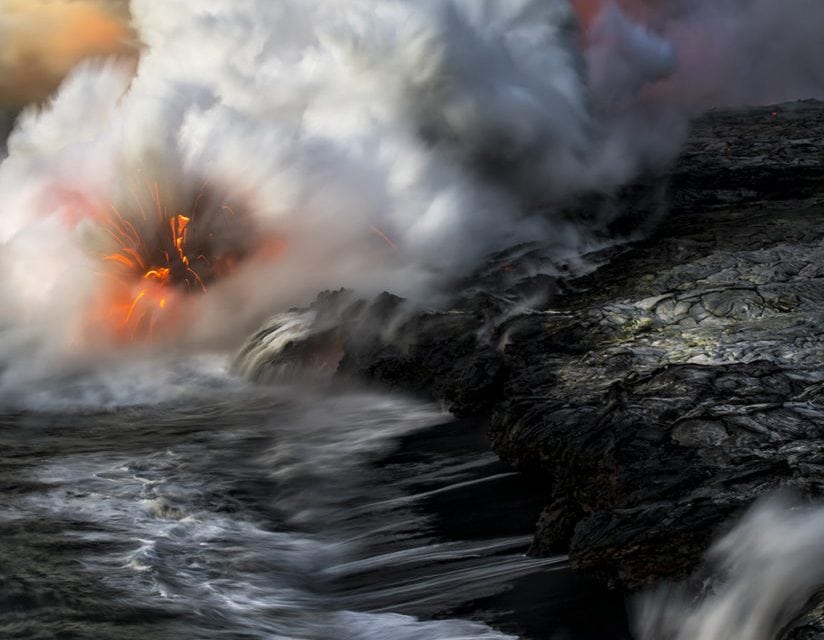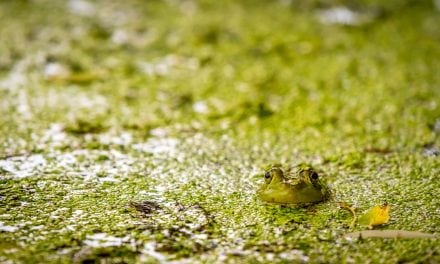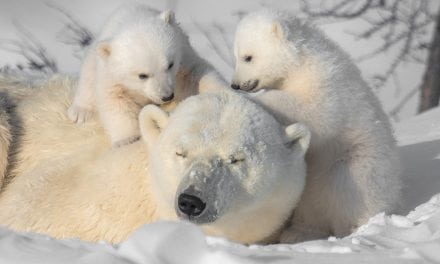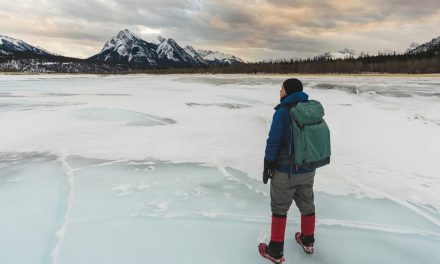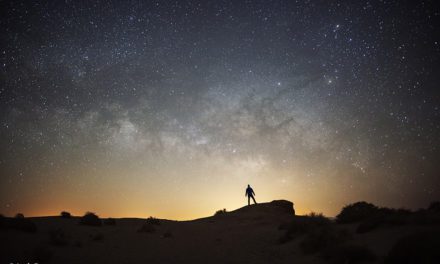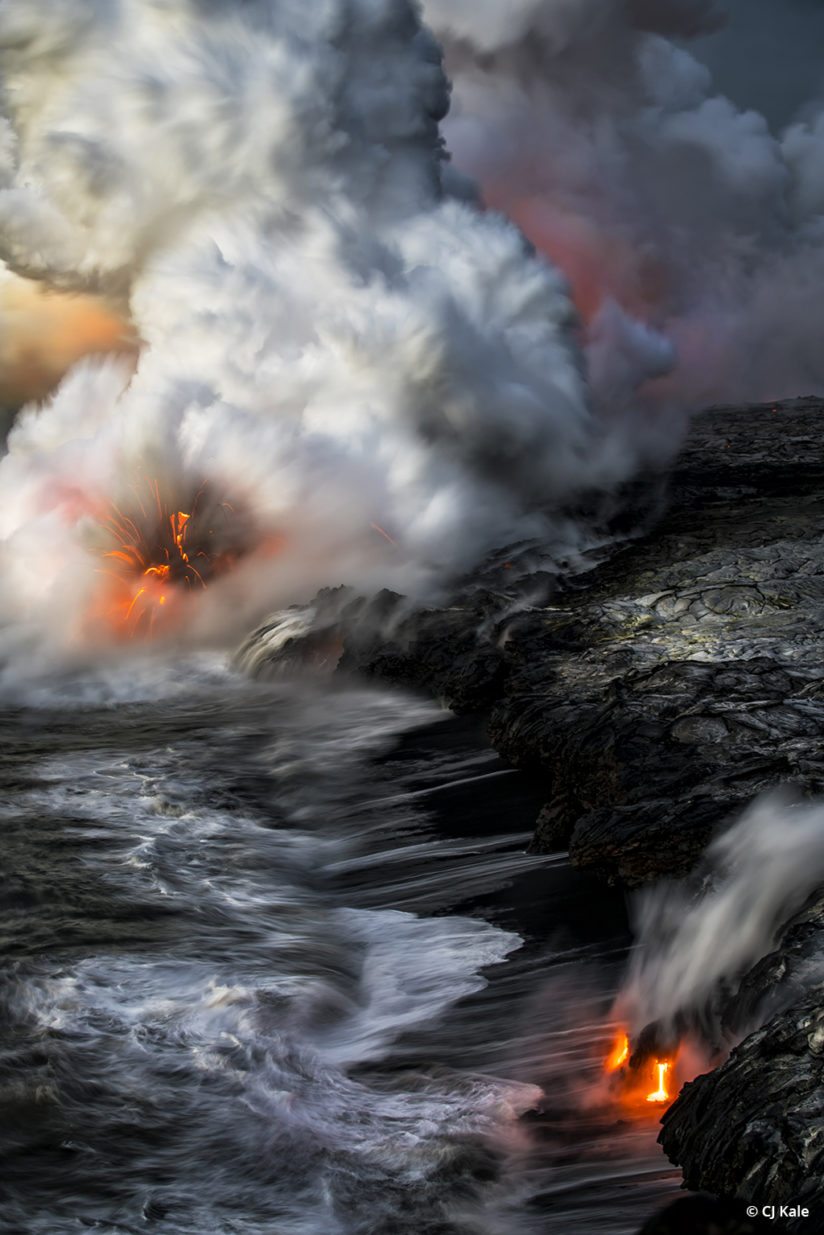
Growing up on Oahu’s Waianae Coast, CJ Kale was exposed to some of the most beautiful landscapes on the planet. Yet it was a fascination with the dynamic forces of nature at work on a neighboring Hawaiian island that shaped his career path. After graduating from New York Institute of Photography, Kale moved to the Big Island to be closer to his favorite subject, Kilauea Volcano at Hawaii Volcanoes National Park, capturing its unfolding drama from land, sea and air. On occasion, he’s pushed in too far for a close up, having to back paddle in scalding surf while avoiding lava bombs after depressing the shutter. The results, however, are some of the most unique photographs of earth creating itself ever taken.
Outdoor Photographer: What is it about volcanoes that make them an endless source of inspiration for you?
CJ Kale: It’s a continuously changing entity. You can stand 2 feet from where you were the day before and never get a photo that looks quite the same. If Ansel Adams had my dilemma, he would have woken up in the morning and said, “I want to go and photograph Half Dome. I wonder where it’s going to be today? What shape is it going to take?” You not only have the changing light, weather and ocean conditions, you have changing lava conditions.
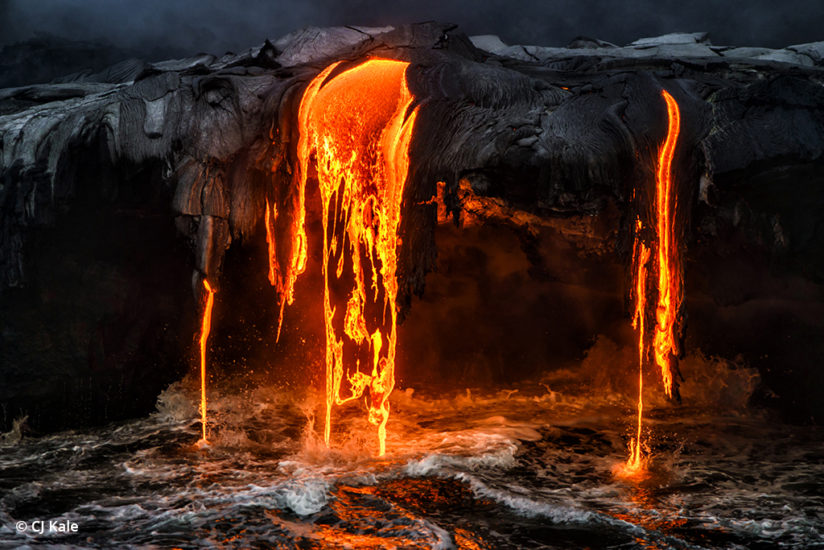
I mainly focus on the Kilauea. In order for me to shoot, it’s a 2.5-hour drive out from where I live in Kona to the volcano, normally an hour hike out. I spend about three hours there, hike back an hour, then drive back 2.5 hours.
OP: Do you need permits to shoot where you hike into?
CK: There are times that you do when it’s over state areas. Right now where it’s at, Volcanoes National Park has provided really good access. They have some safe viewing areas set up. I’ll also go out and photograph via boat, which gets me much closer but no closer than anybody else is able to get right now because it’s under federal control within Hawaii Volcanoes National Park boundaries. You have to go on one of the tour company boats. I recommend See Lava. Their boat goes out of Pohoiki, an hour from Hilo. The interaction between the ocean and the lava is the most dynamic interaction there is. The Hawaiian people used to believe that it was the fire goddess Pele and her sea goddess sister Nā-maka-o-Kahaʻi doing battle at the shore, it’s that violent.
OP: How do you go about capturing that in a still image when you’re back on terra firma?
CK: If the water has a nice draw to it, the exposure is normally around 1/3 sec. If I can get a drip at 1/3 sec. and wait for the light of the sun to come up and fill it, I’ll probably have only about a two-minute window first thing in the morning where everything is balanced. Expose for the lava and wait for it to get bright enough for the fill. I’ll get everything framed up and wait for that epic light. Often, though, by the time the light’s perfect, my framing is completely different. I have to adapt and change at all times.
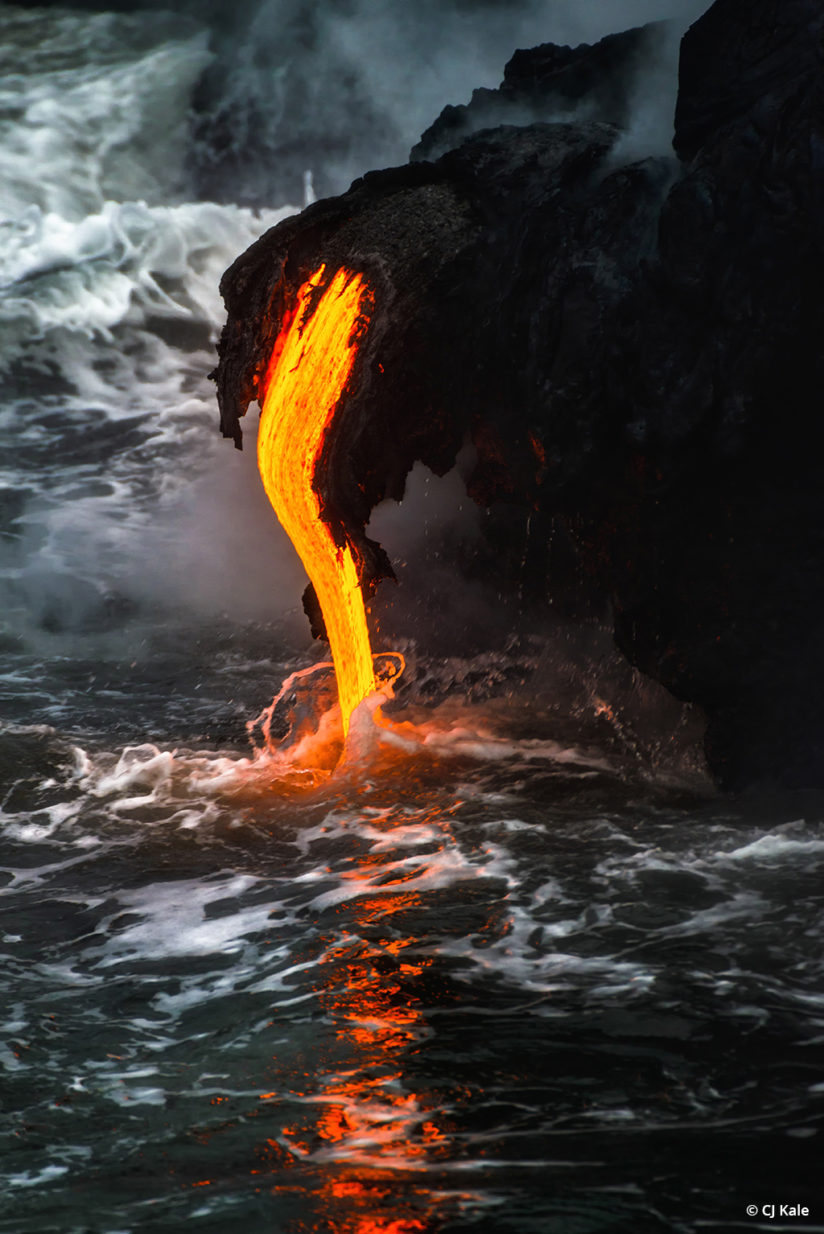
OP: You literally have to go with the flow. Do you use any filters to get the most out of your subject matter?
CK: Everything is in one single shot, so all my light is balanced using grads when needed. I do process a RAW file, but I don’t do compositing, HDR or focus stacking. If I have a bright sky, I’ll balance that using a grad. We often get rainbows, so I use a polarizer to bring that out. I do a lot of flagging techniques, almost like dodging and burning in the darkroom, because the lava is so incredibly bright. I do it in camera. I have that really hot volcano down below, I’ll take a piece of black cardboard and I’ll cover the lava area of the frame and keep moving it around ever so slightly so it creates a soft edge. I’ll block that for the amount of time I need in order to get the right exposure for whatever I want to expose for in the scene. I’ve done the Milky Way over the lava where the lava exposure is less than a second with a 20-second exposure for the night sky.
I’ve used grads upside down, so instead of it being a 1/3 sec. exposure, I’ll use a 3-stop grad and get it down to a one-second exposure, then use the flagging technique on top of that to get it to where I can balance everything in one shot. Live view [camera mode] has made it really easy. I bring the flag up to where it blocks the lava. I’m dodging the light to burn in the hot area.
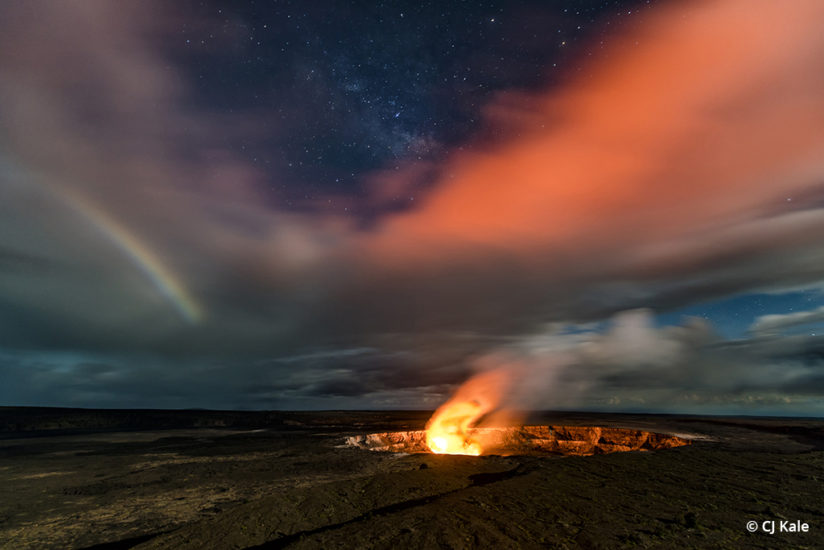
OP: Which grads do you normally use for such specialized shooting situations?
CK: I’m kind of a grad snob. I use the Schneider water-white glass. They’re amazing. I love Lee if I’m going to use resin-coated filters, but the volcanic ash scratches up that type of coating. When I’m trying to blend light into a scene, I might use a 2-stop hard grad on the horizon and double it up with a 2-stop softer grad. I get four stops that blend in nicely.
OP: What camera equipment are you working with?
CK: I’m a big fan of the Nikon D800E and the Sony a7R II cameras. I sometimes work with a Toyo View with film, but it’s gotten expensive. The Sony has a little bit of a focus problem out at the volcano because it uses contrast detect. You really have to manually focus it. The Nikon will autofocus correctly most of the time at the volcano, but I still double-check it by hitting autofocus, then zooming in on live view to make sure I have critical focus. Right now the viewing area is set back a bit, so I’m really loving the Sigma 150-600mm f/5-6.3 on the Nikon. It’s tack sharp. It’s a slower lens, but I’m on a tripod.
OP: Do you have a “go-to” exposure?
CK: It depends on the brightness of the rocks. Photographing the volcano, you’re dealing with two lighting sources. It’s like trying to shoot a sunset and you decide to have a light on your model, but your assistant controlling your light is a monkey and he keeps changing the light value on you. Now, call your settings out to me. The main thing is to expose for the brightness of the lava you want to capture.
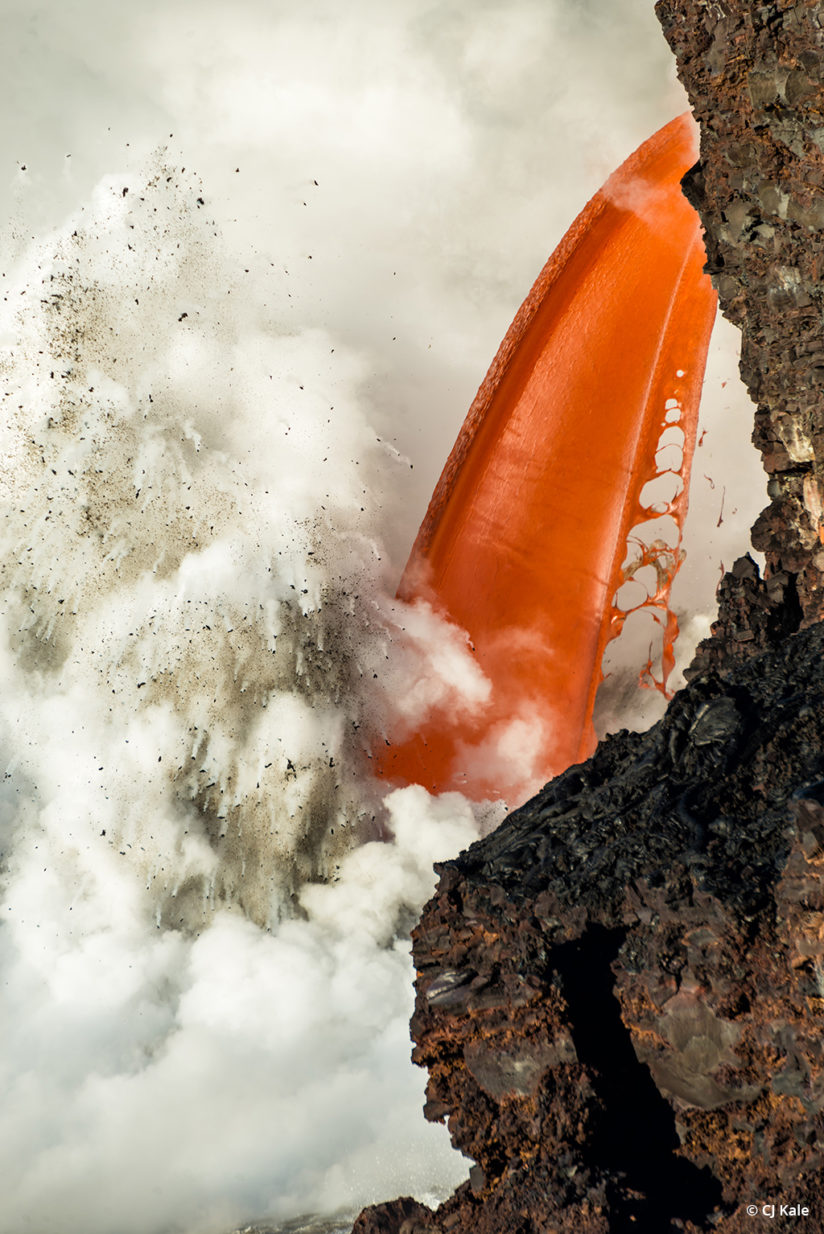
The other day I did a shot of a big lava explosion and a huge fire hose of lava. The two-second exposure I was doing for the lava explosion would not work for the fire hose. With the fire hose right there, you couldn’t do two seconds. But when a big enough explosion would happen, there would be so much black coming up for the explosion that it would cover the fire hose. So for that one exposure, because that fire hose would be covered in smoke, it would be viewable and you could get your two-second exposure of the explosion of the lava rocks. But those values would not work for the fire hose. It was knocked down tremendously, to just a glow behind the clouds. I could also have used a grad.
OP: So, in effect, the smoke acted as a scrim.
CK: If I wanted to expose for the fire hose, my shutter speed would be so short that I would just get stop motion on the rocks. I would lose the trail.
OP: How do you protect yourself from the lava as well as the gases and heat emanating from the earth? There’s a shot of glowing lava trails arching toward you that must have put you in harm’s way?
CK: I hike out in tennis shoes and surf baggies. My protective gear are my wits and not putting myself in a bad situation. You’re talking about my image I named “Almost Famous.” That was with a 16-35mm lens at around 18mm. Stratovolcanoes explode; our shield volcanoes here in Hawaii flow out and every once in a while have a small eruption. The shot took probably the longest two seconds of my life. Projectiles landed about 2 feet in front of me, one or two flew over my head, a bunch went off to the side. This is not me going out and purposely putting myself in a position where I’m standing in front of explosions. That night it had been exploding about 100 feet in the air and nowhere near where I was. That particular explosion doubled its height and came right towards me. When lava flies out as rocks, it cools rather quickly but you’re still talking an instant third-degree burn.
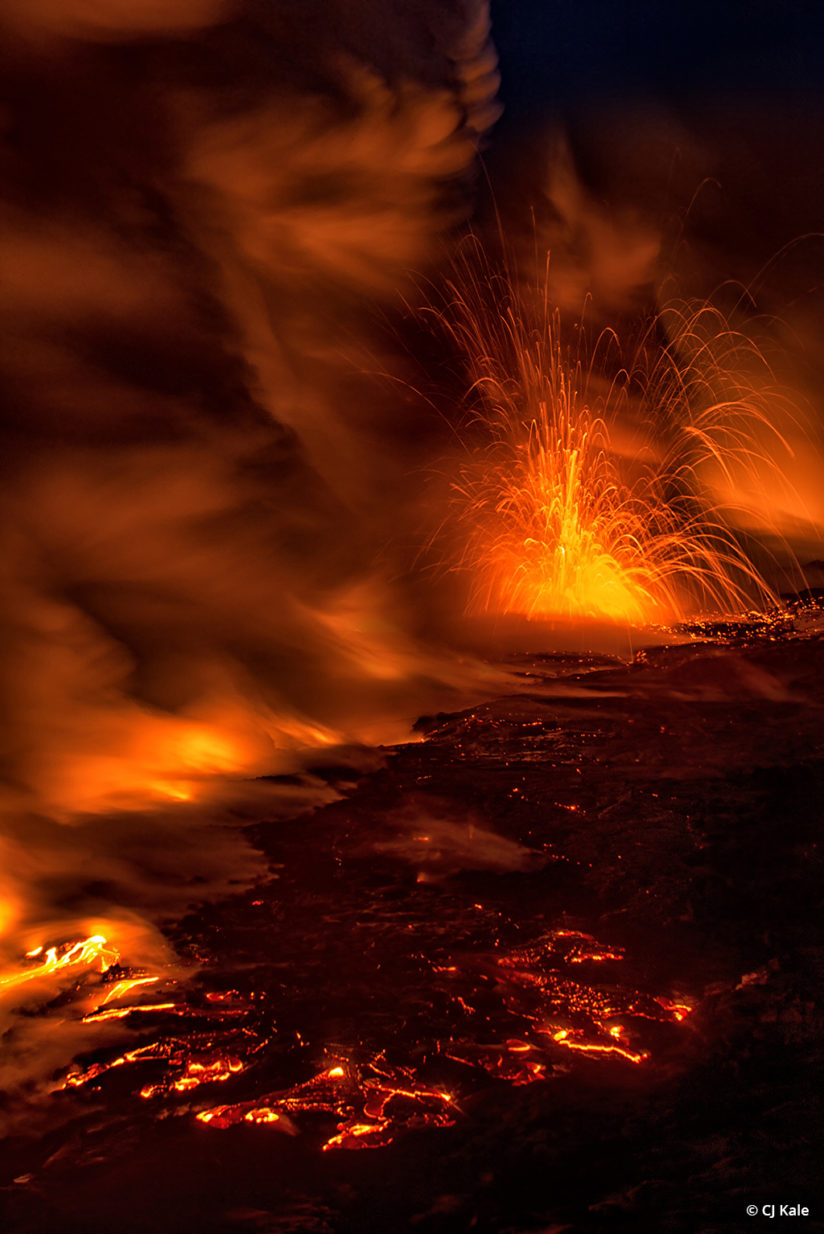
OP: Have you ever been injured?
CK: I’ve been burned in the surf doing lava wave photos. That was back in the days when there were no rules on the books about it. You’re definitely not allowed to do it within the national park area. I went swimming about 20 feet from an active volcano to get wave photos with lava flowing into the barrel of them. There were floating lava bombs coming up. I used a SPL water housing to protect the camera for those shots. Once in a while, a bad situation will find you.
One time I fell about 20 feet into a lava tube, obviously one without lava in it. The ones with lava have pressure and heat, meaning that it’s trying to push up against your feet. Normally your weight won’t cause you to go in it. But after that tube vacates, years of water and rain will weaken it. I stepped on the ceiling of a tube and fell in, shattering an ankle. I was with my photographic partners, Nick Selway and Don Hurzeler. I had to climb out of the tube on my own, we had no ropes to get me out. I extended my tripod legs and hooked my bag on top of it to lift it up so Nick could climb down far enough to grab it, then slowly made my way up. We then lashed my foot to a tripod leg with a camera strap and a belt and hiked back out to the car, then drove to the hospital. I found out I’m not invincible but that they could rebuild me. I’ve got a plate, seven screws and two pins in that ankle.
OP: Are you using drones or helicopters for dramatic shots and unique angles that keep you out of harm’s way?
CK: Every once in a while. I have a Phantom 4 Pro but there’s a TFR—a temporary flight restriction zone—around the volcano for 300 feet around and 1000 feet high around the ocean entry point because we had a 26-acre bench collapse into the ocean, which left a lava hose jetting 60 feet high into the water. There are a lot of explosions resulting from that.
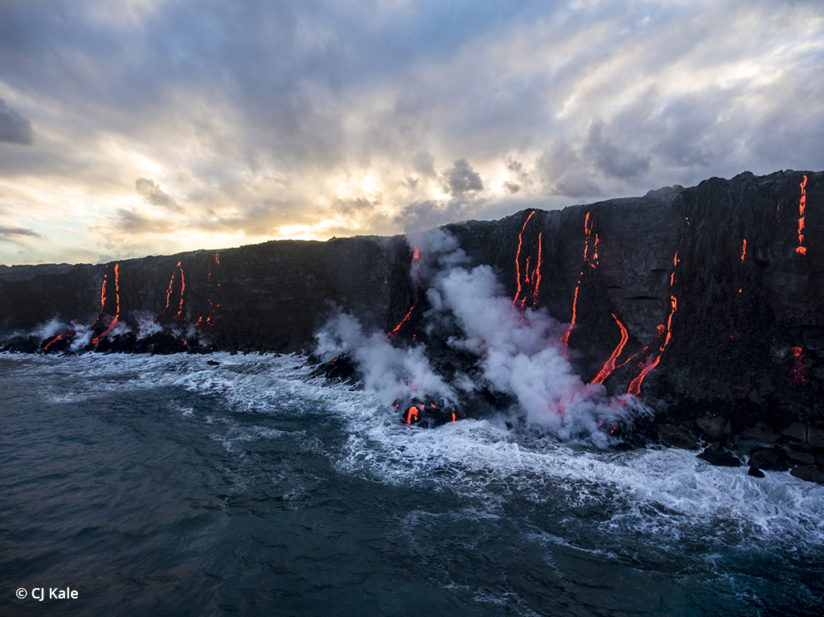
I don’t shoot from helicopters because they fly too high for my liking and aren’t allowed to fly during the best hours of light. When the light is great and you have that great glow of the lava, the helicopters are parked. In the ‘60s, ‘70s and ‘80s, you could fly low and at the more dramatic times of day. There are more safety regulations in place now. It’s still a great experience for visitors.
OP: Your up close and personal experiences with Kilauea are seen by a constant flow of visitors from around the world to the Big Island.
CK: We have two Lava Light Galleries in Kona and Waikoloa. Back in the day, we used to do Cibachrome. Now we’re doing a lot of printing on metal. It really transmits the feeling of being there.
See more of CJ Kale’s work at lavalightgalleries.com.
The post Boom, Baby! appeared first on Outdoor Photographer.

